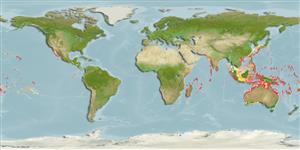Common names from other countries
>
Gobiiformes (Gobies) >
Gobiidae (Gobies) > Gobiinae
Etymology: Fusigobius: Latin, fusus = spindle + Latin, gobius = gudgeon (Ref. 45335).
More on authors: Hoese & Reader.
Environment: milieu / climate zone / depth range / distribution range
Ecologia
marinhas associadas(os) a recifes; intervalo de profundidade 1 - 46 m (Ref. 90102). Tropical
Indo-West Pacific: East Africa to the Society Islands, north to the Ogasawara Islands.
Tamanho / Peso / Idade
Maturity: Lm ? range ? - ? cm
Max length : 6.0 cm TL macho/indeterminado; (Ref. 2798)
Descrição suscinta
Chaves de identificação | Morfologia | Morfometria
Espinhos dorsais (total) : 7; Raios dorsais (total) : 9; Espinhos anais: 1; Raios anais : 8. Body with dark dots found in rows; spot on caudal peduncle (Ref. 2798); characterized by semi-translucent grey body with orange-brown spots and blotches; outer part of first dorsal fin with two black spots; nearly fully united pelvic fins; weak pelvic frenum; rounded caudal fin; longitudinal scale series 24-25; ctenoid body scales becoming cycloid anterior to pectoral and pelvic fins; operculum without scales; opening of gill extending to or almost to vertical at posterior edge of opercle; depth of body 4.3-5.8 in SL (Ref. 90102).
Inhabits sandy floors of holes and depressions of clear seaward reefs. Also found in sand-rubble bottoms next to reefs (Ref. 90102). Occurs singly or in groups, secretive. (Ref. 37816, 48637). Benthic (Ref. 58302). Feeds on small invertebrates (Ref. 89972).
Ciclo de vida ou comportamento de acasalamento
Maturities | Reprodução | Spawnings | Egg(s) | Fecundities | Larvas
Randall, J.E., 1995. Fusigobius Whitley, a junior synonym of the gobiid fish genus Coryphopterus gill. Bull. Mar. Sci. 56(3):795-798. (Ref. 10930)
Status na Lista Vermelha da UICN (Ref. 130435)
CITES (Ref. 128078)
Not Evaluated
Ameaça para os humanos
Harmless
Uso pelos humanos
Ferramentas
Relatórios especiais
Baixar XML
Fontes da internet
Estimates based on models
Preferred temperature (Ref.
115969): 24.5 - 28.8, mean 27.5 (based on 582 cells).
Índice de diversidade filogenética (Ref.
82804): PD
50 = 0.5005 [Uniqueness, from 0.5 = low to 2.0 = high].
Bayesian length-weight: a=0.00708 (0.00333 - 0.01504), b=3.09 (2.92 - 3.26), in cm Total Length, based on LWR estimates for this (Sub)family-body shape (Ref.
93245).
Nível Trófico (Ref.
69278): 3.2 ±0.3 se; based on size and trophs of closest relatives
Resiliência (Ref.
120179): Elevada, tempo mínimo de duplicação da população menor que 15 meses (Preliminary K or Fecundity.).
Fishing Vulnerability (Ref.
59153): Low vulnerability (10 of 100).
